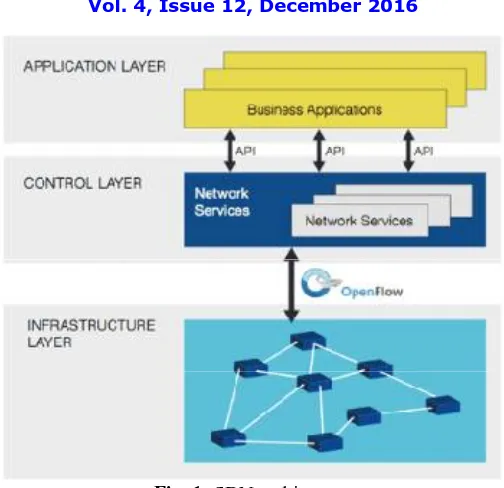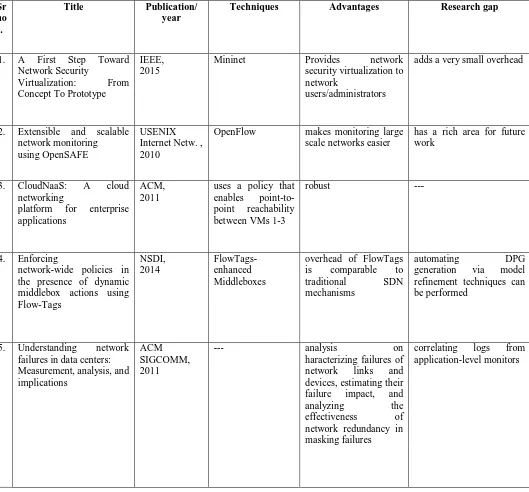Review on Network Security Virtualization
Schemes
Dharmesh Ghelani, Prof. Vikas Maral
Student, Department of Computer Engineering, K.J. College of Engineering Management Research, Savitribai Phule
Pune University, Pune, India
Asst. Professor, Department of Computer Engineering, K.J. College of Engineering Management Research, Savitribai
Phule Pune University, Pune, India
ABSTRACT: there are various stakeholders having similar goals as well as policies due to which modification to the present internet is restricted to incremental updates; implementation of every novel fundamentally extraordinary innovation is beside inconceivable. To deal with this issue, the concept of network virtualization has designed as a diversifying attribute without having restriction of any system. By permitting multiple heterogeneous system structures to live together on a shared physical substrate, network virtualization gives flexibility, promotes diversity, and promises security and increased manageability. This survey present some previous work done related to above topic.
KEYWORDS: Network virtualization, Security; Threats, Countermeasures.
I. INTRODUCTION
When we consider security for networks, the circumstance is much more complicated. The extra security devices/middle-boxes fundamentally complicate network configuration/ management. Furthermore, security devices have numerous assorted security capacities to fill diverse needs. For instance, we can utilize a firewall to control network access, a network intrusion detection system (NIDS) to perform monitoring of exploit attacks in network payloads, and a network anomaly detection framework to identify DDoS attacks. Thusly, the network administrator should pick sensible security functions/devices and deploy them into reasonable places. Be However, it is a tough task for the administrator, since it is difficult to predict possible network threats of various network tenants and the administrator is not ready to know about requests of various tenants in advance. In this manner, those introduced security functions/appliances/devices may not be in the best areas that can best serve the different security needs of various network clients. Clearly, there is an urgent need to boost the resource use of those existing pre-installed devices/boxes, as well as abstract these security resources to give a straightforward interface for network tenants to utilize.
Fig. 1: SDN architecture
A “Network intrusion detection system (NIDS)” monitors network traffic looking out for any suspicious activity, which could be unauthorized activity or an attack. A scaled up NIDS server can be set up on a network backbone, to monitor all traffic; or smaller systems can be set up for traffic monitoring on a particular server, switch, gateway, or router. In addition to monitoring ingress and egress network traffic, a NIDS server can also scrutinize system files checking for unauthorized activity and to maintain file and data integrity. The NIDS server can also detect changes in the server’s core components. In addition to traffic monitoring, NIDS server can additionally scan server log files and look for suspicious traffic or usage patterns that match a typical network compromise or a hacking attempts. The NIDS server can also perform a proactive role instead of a reactive function. Possible uses include scanning local firewalls or network servers for scanning live traffic or potential exploits to infer what is going on. Keep in mind that a NIDS server does not replace primary security such as firewalls, encryption, and other authentication mechanism. The NIDS server is a fallback network integrity device. Neither system (primary or security and NIDS server) should replace common precaution (building physical security, corporate security policy, etc.)
In this survey, Section II gives the Literature review for Network Monitoring and Trust Routing systems and also list there pros and cons.
II. RELATED WORK
This paper [1] present a new concept of network security virtualization, which virtualizes security functions/resources to network users/administrators, and thus maximally utilizing existing security devices or middle-boxes. In addition, it provides protection to configured networks with minimal management cost. To verify this concept, we further design and implement a prototype system, NETSECVISOR, which can utilize existing pre-deployed (fixed-topology) security devices and leverage software-defined networking technology to virtualize network security functions.
In this paper [3], authors present the design and implementation of an innovative cloud networking system called CloudNaaS. Customers can leverage CloudNaaS to deploy applications augmented with an extensible and rich flnetwork functions sets such as virtual network isolation, custom addressing, service differentiation, and flexible interposition of numerous middleboxes. CloudNaaS primitives are implemented within the cloud infrastructure directly using high-speed & programmable network elements, making CloudNaaS highly efficient. They evaluate an OpenFlow-based CloudNaaS prototype and find that it can be used to instantiate various network functions in the cloud, and that its performance is highly robust even in the times of large scale provisioned link/device and services failures.
.
This paper [4] propose FlowTags, an extended SDN architecture in which middleboxes add Tags to outgoing packets, to provide the necessary causal context. These Tags are used on switches and middleboxes for systematic policy enforcement. They discuss the early promise of minimally extending middleboxes to provide this support. They also highlight open challenges of south-bound and north-bound FlowTags APIs design; new controllayer applications for enforcing & validating policies and automatically modifying legacy middle-boxes to support FlowTags.
This paper [5] presents architecture for adding functionality to networks via outsourcing. In this model, enterprise network just forwards data; any further processing is performed via external Feature Providers (FPs). FPs provide & manage features, moving them in response to customer’s demand and providing automated recovery for failures. Benefits to enterprise include cost reduction & management complexity, improved features via FP specialization, and better choice in services.
The paper [6], present the first large-scale analysis of failures in a data center network. Through our analysis, we seek to answer several fundamental questions: which devices/links are highly unreliable, how do failures impact network traffic, what causes failures & how effective is network redundancy? They answer these questions using multiple data sources commonly collected by network operators. The key findings of this study is that (1) data center networks show high reliability, (2) commodity switches such as ToRs and AggS are highly reliable, (3) load balancers leads in terms of fault occurrences with many short-lived software related faults, (4) failures have potential to cause loss of many small packets such as keep alive messages and ACKs, and (5) network redundancy is only 40% effective in minimizing the median impact of failure.
As shown in table 1, literature review of various papers has been listed, giving possibility of research gap.
Table 1: Survey Table
Sr no
.
Title Publication/ year
Techniques Advantages Research gap
1. A First Step Toward Network Security
Virtualization: From Concept To Prototype
IEEE, 2015
Mininet Provides network security virtualization to network
users/administrators
adds a very small overhead
2. Extensible and scalable network monitoring using OpenSAFE
USENIX Internet Netw. , 2010
OpenFlow makes monitoring large scale networks easier
has a rich area for future work
3. CloudNaaS: A cloud networking
platform for enterprise applications
ACM, 2011
uses a policy that enables point-to-point reachability between VMs 1-3
robust ---
4. Enforcing
network-wide policies in the presence of dynamic middlebox actions using Flow-Tags NSDI, 2014 FlowTags-enhanced Middleboxes
overhead of FlowTags is comparable to traditional SDN mechanisms
automating DPG generation via model refinement techniques can be performed
5. Understanding network failures in data centers: Measurement, analysis, and implications
ACM SIGCOMM, 2011
--- analysis on haracterizing failures of network links and devices, estimating their failure impact, and analyzing the effectiveness of network redundancy in masking failures
III.PROPOSED WORK
A SYSTEM ARCHITECTURE
Fig.1. System Architecture
IV.CONCLUSION
This paper analyses various techniques used for Network Monitoring and Trust Routing. Also given the advantages and drawbacks present in the different studies performed by various researchers. To deal with drawbacks in present systems we presented an idea of the new system.
REFERENCES
1. Seungwon Shin, Haopei Wang, and Guofei Gu, “A First Step Toward Network Security Virtualization: From Concept To Prototype”, IEEE TRANSACTIONS ON INFORMATION FORENSICS AND SECURITY, VOL. 10, NO. 10, OCTOBER 2015.
2. J. R. Ballard, I. Rae, and A. Akella, “Extensible and scalable network monitoring using OpenSAFE,” in Proc. USENIX Internet Netw. Manage. Conf. Res. Enterprise Netw., 2010, p. 8.
3. T. Benson, A. Akella, A. Shaikh, and S. Sahu, “CloudNaaS: A cloud networking platform for enterprise applications,” in Proc. 2nd ACM Symp. Cloud Comput., 2011, Art. ID 8.
4. S. K. Fayazbakhsh, L. Chiang, V. Sekar, M. Yu, and J. C. Mogul, “Enforcing network-wide policies in the presence of dynamic middlebox actions using Flow-Tags,” in Proc. 11th USENIX Symp. Netw. Syst. Design Implement. (NSDI), 2014, pp. 533-546.
5. G. Gibb, H. Zeng, and N. McKeown, “Outsourcing network functionality,” in Proc. ACM SIGCOMM Workshop Hot Topics Softw. Defined Netw. (HotSDN), Aug. 2012, pp. 73-78.
6. P. Gill, N. Jain, and N. Nagappan, “Understanding network failures in data centers: Measurement, analysis, and implications,” in Proc. ACM SIGCOMM, 2011, pp. 350-361.


